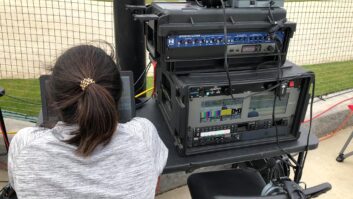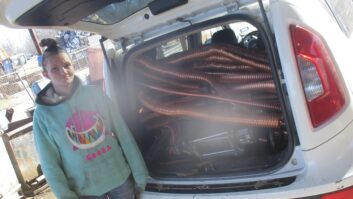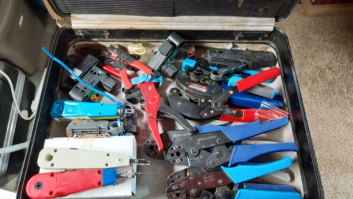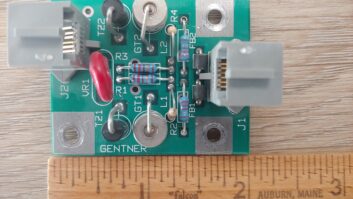The last time I heard from Jim Schropp, he wrote with information on an insulation displacement XLR connector manufactured by Neutrik. We published the information here in Workbench, and a lot of engineers purchased these to have in their toolboxes and remote kits, just in case they needed an XLR and didn’t have a soldering iron handy.
Jim writes that although Neutrik decided to stop making the insulation displacement connector some years ago, he really missed the convenience it offered.
His latest email contained great news. Jim says the company makes a crimp-together XLR that, while not quite as fast to assemble as the IDC connectors, are easy to use, work well and save significant time compared to soldering — especially if you only need to make one or two connectors.
The male connector, shown in Fig.1, is dual-use; it has the crimp pins but can also be soldered. This duality is a nice feature, seen up close in Fig.2. The female connector is crimp-only, but it works well and goes together easily, as seen in Fig.3.

Fig. 1: The crimp-on male connector components are shown.

Fig. 2: Closeup of the male connector shows both solder cups and crimp-on pins.

Fig. 3: The female Neutrik crimp XLR connector.
You do need a B-crimp tool, part number IEC 60352-2. (Jim writes that if you have ever installed a Wheatstone Audioarts console, you have one already.)
The connectors come in black- or nickel-finished housings. Part numbers for the connectors:
Male nickel housing: NC3MXX-HA
Female nickel housing: NC3FXX-HA
Male black housing: NC3MXX-HA-BAG
Female black housing: NC3FXX-HA-BAG
The crimp-on pins come 50 to a bag. Jim recommends buying them so you can re-use connectors and to cover the occasional mistake. Part numbers for the pins:
Male pins HA-3MXX (50 per bag)
Female pins HA-3FXX (50 per bag)
Jim Schropp has been working with his dad Larry for 10 years now. Larry started Schropp Electronics Services in 1982. The company does contract work for stations in both North and South Carolina, as well as consulting and project work up and down the East Coast.
* * *

Fig. 4: Place this warning box by your door as a reminder to reset the remote control.
As busy as our lives can be, it’s the little things we forget — for instance, that we left our remote control in “maintenance override.”
Fig. 4 suggests a great way to remember. Paul Shulins and his engineers at Greater Media Boston mounted this little box right by the transmitter building door. It’s tied to the maintenance mode LED on the remote control. This override indicator is bright enough to catch anyone’s attention, even if you leave the building lights on and it’s the middle of a sunny day.
Spare yourself the irritation of locking out your remote control system by adding a warning light like this. Thanks, Paul, for sharing the idea.
* * *
Wayne Eckert is president of Channel 1 Images; he wanted to pass along a few tips to deter copper thieves.
Since exposed copper looks like solid gold to thieves, hide it. A good way to do so is to coat the copper with roofing mastic. Roofers know this stuff as “bull nose.” It’s a nasty tar-like substance that never really seems to dry up. It gets on anything and everything with which it comes in contact (tools, hands, clothes).

Fig. 5: Not much left of these cable ground kits, hacked off by copper thieves.
Some bull nose mastic on the ground kits in Fig. 5 might have prevented a theft. The material reduces the scrap price of copper to the point the metal becomes almost worthless unless the mastic is burnt off. This not only reduces the price but also increases the thieves’ labor, a double whammy.
Purchase the material at Home Depot or Lowes or any roofing supply store. An example of the product is Gardner 1-Gallon Wet-R-Dri All-Weather Roof Cement.
In situations where applying mastic is not practical, mark up your copper utilizing a stamping set.
These are relatively inexpensive letter stamps that can be used with a lineman’s or handheld sledgehammer to mark up copper permanently with something like “Stolen from WXYZ Radio.” These stamps also can be heated with a heat gun to mark up the jacket of Heliax, though be careful not to push the heated stamp all the way through the jacket. The stamps work well for marking up plastic equipment cases to keep them from growing legs.
Several stamp sets are available from www.use-enco.com. Enter “Steel Stamp Set” in the search box.
Then there is prosecution. If the crooks are in custody, do all that you can to assure they are convicted. Station management may want to call in markers with city hall to assist, and let local media outlets including newspapers and television know.
Another thought: State courts may not treat your copper theft as the crime of the century; but if the incident involves an air conditioning system, management would be well advised to bring it to the attention of the U.S. Attorneys Office. While there are no federal laws against copper theft, intentionally releasing Freon is a serious crime that can bring with it long prison terms and steep fines. Wayne writes that it’s a no-brainer for the USAO to prosecute, since few copper thieves have the proper EPA 608/609 license or refrigerant recycling equipment. (Does it seem far-fetched that copper thieves could be snagged on a Freon angle? Read about one such case attinyurl.com/rwtheft.)
Contribute to Workbench! You’ll help your fellow engineers, and qualify for SBE recertification credit. Send Workbench tips to [email protected]. Fax to (603) 472-4944.
Author John Bisset has spent 43 years in the broadcasting industry, and is still learning! He is SBE Certified, and is a past recipient of the SBE’s Educator of the Year Award.












